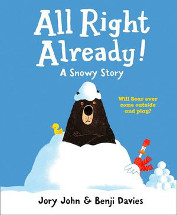All right already! by Jory John and Benji Davies

HarperCollins, 2019. ISBN: 9780008330033.
Bear and Duck are neighbours - but two more different would be hard
to find. Bear is huge, slow and somewhat grouchy; Duck small,
energetic and always looking for fun. Told in dialogue with each
character having their own font that cleverly echoes their nature,
each story focuses on a conflict between the two as Bear wants one
thing - usually a quiet life - while Duck wants the opposite. And it
is the same in this latest addition to this series for very young
readers...
It has snowed overnight and Duck wants to make the most of the fun
it offers while Bear wants to stay in his cosy warm house. Even
after Duck coaxes him out he is a reluctant participant in the games
and when he starts to sneeze, Duck bundles him back inside (where he
wanted to be all the time) and assumes the role of nurse. But
Bear is not particularly grateful and when Duck begins to sneeze too
and heads for her home, it remains to be seen whether Bear will step
up and nurse her.
Apart from being a charming story that young readers will enjoy,
there is much it offers for the development of early reading
behaviours for them as well. Firstly, being a series, it is an
opportunity for the adult to ask the child what they remember and
know about the characters already so their thoughts are already set
to the contrasting characteristics of each. When Duck goes to
Bear's house, full of excitement and anticipation, what sort of
reception is she likely to get? There is also the opportunity
to explore the concept of dialogue as the whole story is told in
conversation with Duck's voice in a different, lighter font to that
of Bear's. It offers lots of things to chat about such as why it
snows and why most Australian children won't wake to a snowy
morning; how we need to protect ourselves from catching a cold and
how we can keep from spreading the one we have, and also the things
we can do to make a friendship solid and sustainable.
While bedtime stories should always be about the bond and the
connections between reader and listener, there are subtle ways that
these concepts about print can be shared so that the young one
engages even further with the story and becomes even more determined
to become an independent reader.
Barbara Braxton